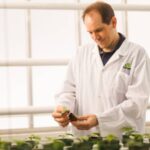
Managing Labor in the Current Environment
It isn’t news to farmers that the agri-labor market is a current challenge. The shortage in able-bodied workers and difficulty filling H2-A Visas, plus the added financial burdens the current requirements for utilizing H2-A workers makes it difficult for greenhouse owners to fill their workforce. At this year’s Great Lakes EXPO and Michigan Greenhouse Growers Expo, educational sessions will focus on the agri-labor market. We sat down with a few of the speakers; here’s a preview of what you can expect from those sessions.
Luckily, most greenhouse owners aren’t constrained by the government on the number of H2-A Visas they receive. In situations where domestic labor isn’t available, visas are generally approved.
Greenhouses still struggle; since many of them run year-round and H2-A Visas are only temporary, greenhouse proprietors must try to get H2-B labor as frequently as they can. H2-B Visas are currently capped at well under 100,000 workers, which is a fraction of the need. What this means is that greenhouse proprietors must obtain H2-A Visa workers to fill out their workforce and rotate workers every 10 months.
The legislature is working on some solutions. The proposed H2-C would be capped at 410,000 workers (out of an estimated need of 2.5-2.7 million, depending on the Extension study referenced) but could possibly eliminate H2-A Visas altogether.
The National Council of Agricultural Employers (NCAE) is lobbying hard to prevent a labor shortfall catastrophe that could occur if H2-A is eliminated in favor of the capped H2-C. Michael Marsh, CEO of the NCAE, said, “We have seen a significant increase in total number of employers using H2-A Visas. Sixteen percent year over year were certified this last season. And over five years, we have seen the same level of growth.”
At this rate, if growers are forced to move to the H2-C Visas and contend with the staffing needs of dairy farmers, fruit and vegetable farmers and other industries as well, it will be a major challenge to get crops harvested.
If the H2-A continues to be used, the NCAE hopes to have the process streamlined so that farmers do not need to have such extraordinary costs and so that it is more user-friendly. “Many in our industry are assessing their options in the face of a worsening labor situation. For more and more growers, that may mean H-2A, the agricultural worker visa program for seasonal (less than 10 months) labor needs,” said Craig Regelbrugge, senior vice president of AmericanHort.
It is also difficult to promote a seasonal job to domestic workers who need to feed their families year-round. Even if domestic employees can fill the positions, growers need to be prepared for those employees to find work elsewhere at any moment. Adam Kantrovich of Clemson Extension in Agribusiness, said, “While it is one thing to look at historical data and another to speculate what will happen in the future, I think we can expect more movement toward increasing the need for H2-A or similar visas.”
 Human trafficking has been an increasing issue in our nation and farmers can be on the front lines defending against it. Jeremy Norwood, an expert in the prevention of human trafficking, will speak on ways farmers can help in this fight.
Human trafficking has been an increasing issue in our nation and farmers can be on the front lines defending against it. Jeremy Norwood, an expert in the prevention of human trafficking, will speak on ways farmers can help in this fight.
“Given the worsening labor situation, despite the bureaucratic and cost challenges, H-2A is growing by leaps and bounds. The number of positions for which H-2A workers were requested topped 200,000 in FY2017,” said Regelbrugge.
On the horizon is the potential for automation to positively impact the labor shortage problems growers are facing.
As of right now, the capital required for moving toward automation is out of reach for most small and medium operations. Automation is available and prices are going down the longer the technology is on the market. Growers can look forward to this as an option in coming years.
The Great Lakes Expo and Michigan Greenhouse Growers Expo will take place Dec. 4-6, in Grand Rapids, Michigan. Registration will open in October 1, 2018.


 Video Library
Video Library 



















